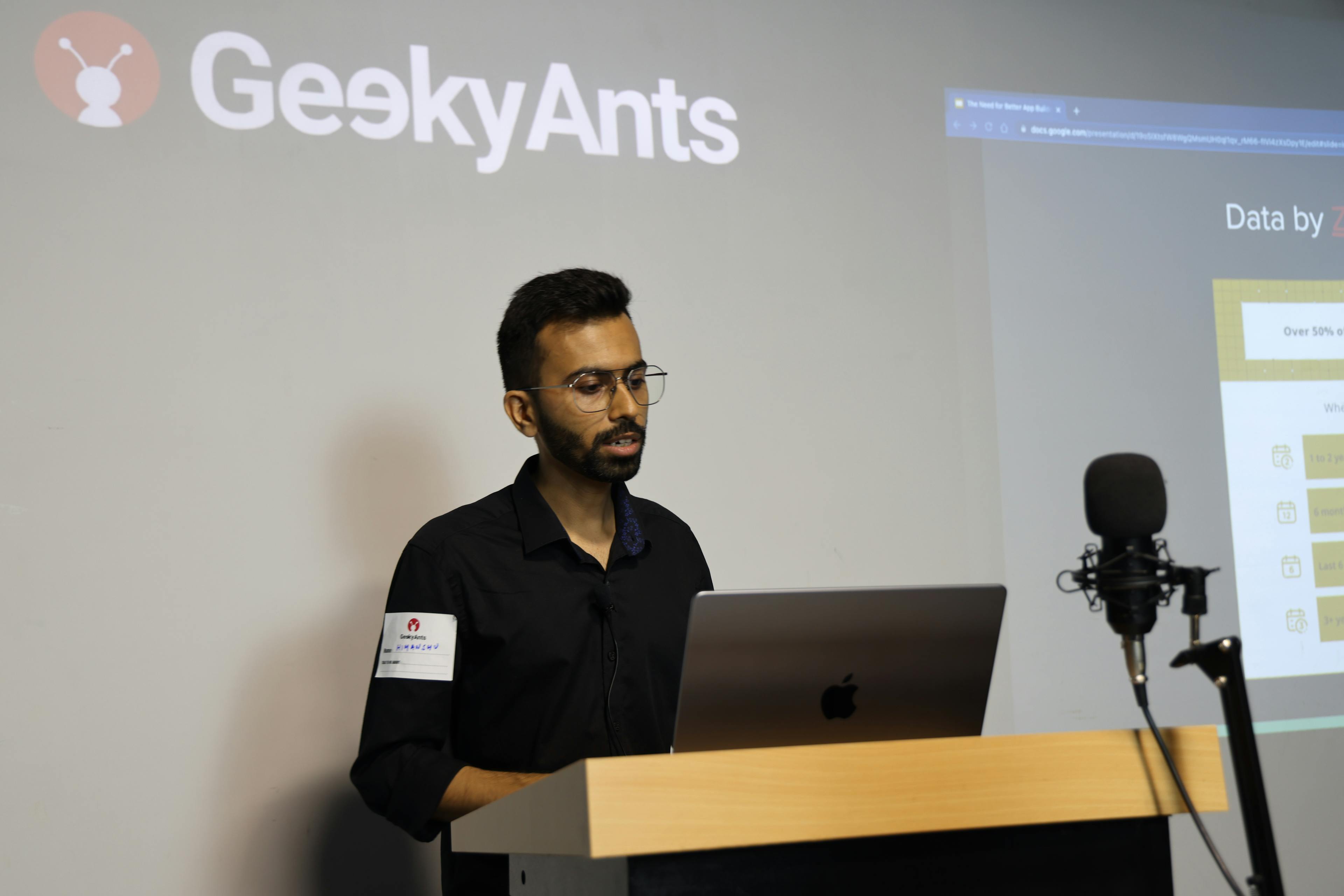Low-Code/No-Code Hybrid Meetup @ GeekyAnts, August 2022
Author

Date

Book a call
On 13th August 2022, we hosted our first hybrid Low-Code/No-Code Meetup at the GeekyAnts office. It was a get-together of enthusiastic techies curious about the new trends in minimal code structures.
The meetup was kicked-off with a keynote address from GeekyAnts CEO, Sanket Sahu. After him, Himanshu Satija took the floor and discussed the need for better app builders.
Next up was serial entrepreneur Saurav Arya. He discussed the emergence of citizen developers. He was followed by Mayank Pagar who highlighted the potential of a headless CMS as a low-code solution.
The finale was a panel discussion of experts moderated by Yashasvi, Growth & Marketing Lead.
Here’s a quick read of everything discussed at the event:
The Need for Better App Builders by Himanshu Satija

Himanshu Satija, a software engineer and YouTube enthusiast, took the stage first. He tapped into his experience with BuilderX and low-code tools to illustrate the need for better app builders.
He started off by presenting an extremely insightful graph that explained the use of no-code and low-code technologies and their promising future.
The introduction was followed by some details on the different kinds of app creators and the difficulties they face. The key difficulties are, among others, application complexity and interaction with already-existing businesses.
Additionally, he elaborated on alternatives to intermediary handoffs between designers and developers, one of which is Figma.
He concluded with a few remarks on a number of concerns regarding the future of app developers and the lack of code structures.
The Rise of Citizen Developers by Saurav Arya

Saurav Arya was our second guest speaker. He joined us virtually and highlighted how citizen developers are assessing the power of machine learning (ML) in the form of sentiment analysis and levity.ai with the help of low-code structures.
During his gap year, mechanical engineer Saurav, who had little to no coding expertise, experimented with a no-code building tool. This was the beginning of his amazing entrepreneurial journey in this brilliant environment. With the use of no-code stacks, Saurav created several amazing products. JustShipIt (a community of code builders) and Smallworld (hospitality) are great examples.
He also had an interesting statistic to share: The number of non-coders in the world and the potential to empower them through a no-code or low-code ecosystem.
Saurav refuted any claims that no-code stacks are unscalable and unimpressive. He mentioned numerous successful no-code businesses like Dividend Finance, Markerpad, and Plato as examples.
He concluded by predicting that this ecosystem will be worth multiple billions of dollars, and provide the necessary push for all non-coders to realise their ideas into working products.
The potential of headless CMSs as low-code tools by Mayank Pagar

The next talk was delivered by our in-house geek, part of the NativeBase core team at GeekyAnts, Mayank Pagar.
Mayank gave a brief overview of CMS and its advantages. He also quickly emphasised SEO-friendly features and pre-designed template possibilities that CMS offers to its consumers.
He highlighted how traditional CMS is the go-to tool for producing websites. It is quick and a great way to speed up the creation of a website. This is because it uses a single codebase for both the frontend and the backend. Additionally, he highlighted the difficulties it encounters when switching between desktop and mobile applications.
He also spoke about the necessity of an API that could speed up website creation by retrieving content and allowing the builder to use it however they saw fit.
In relation to all of the company's materials and assets, "Headless CMS serves as a single source of truth," he claimed.
Due to its capability for quick content deployment and multichannel content distribution, Mayank emphasised the adoption of headless CMS. He referenced StrapI and Contentful, two popular CMS systems that properly contained all of the CMS's functionality.
In his concluding remarks, he underlined the necessity for a framework that would enable the development of visual editing experiences with a decoupled API as a service.
Panel Discussion (Himanshu, Saurav, Sanket & Mayank, moderated by Yashasvi)

The event concluded with a panel discussion that explored the future of low-code and no-code infrastructures and the incumbent vacuum that exists in the ecosystem. Everyone agreed that a revolution was hitting soon. To be ahead of the pack, it will become necessary to adopt the system at the earliest.
You can watch the live event here.
Dive deep into our research and insights. In our articles and blogs, we explore topics on design, how it relates to development, and impact of various trends to businesses.





